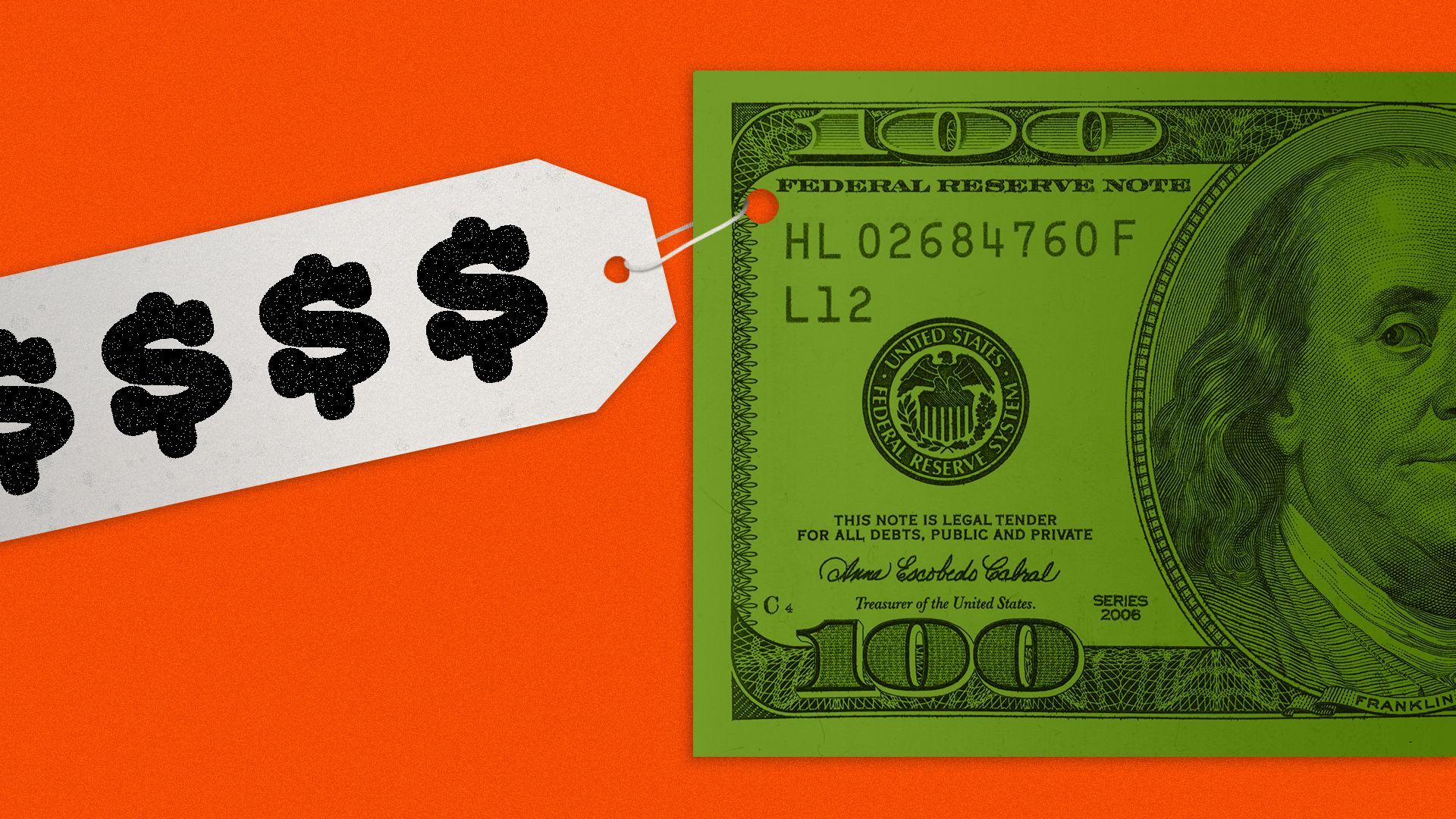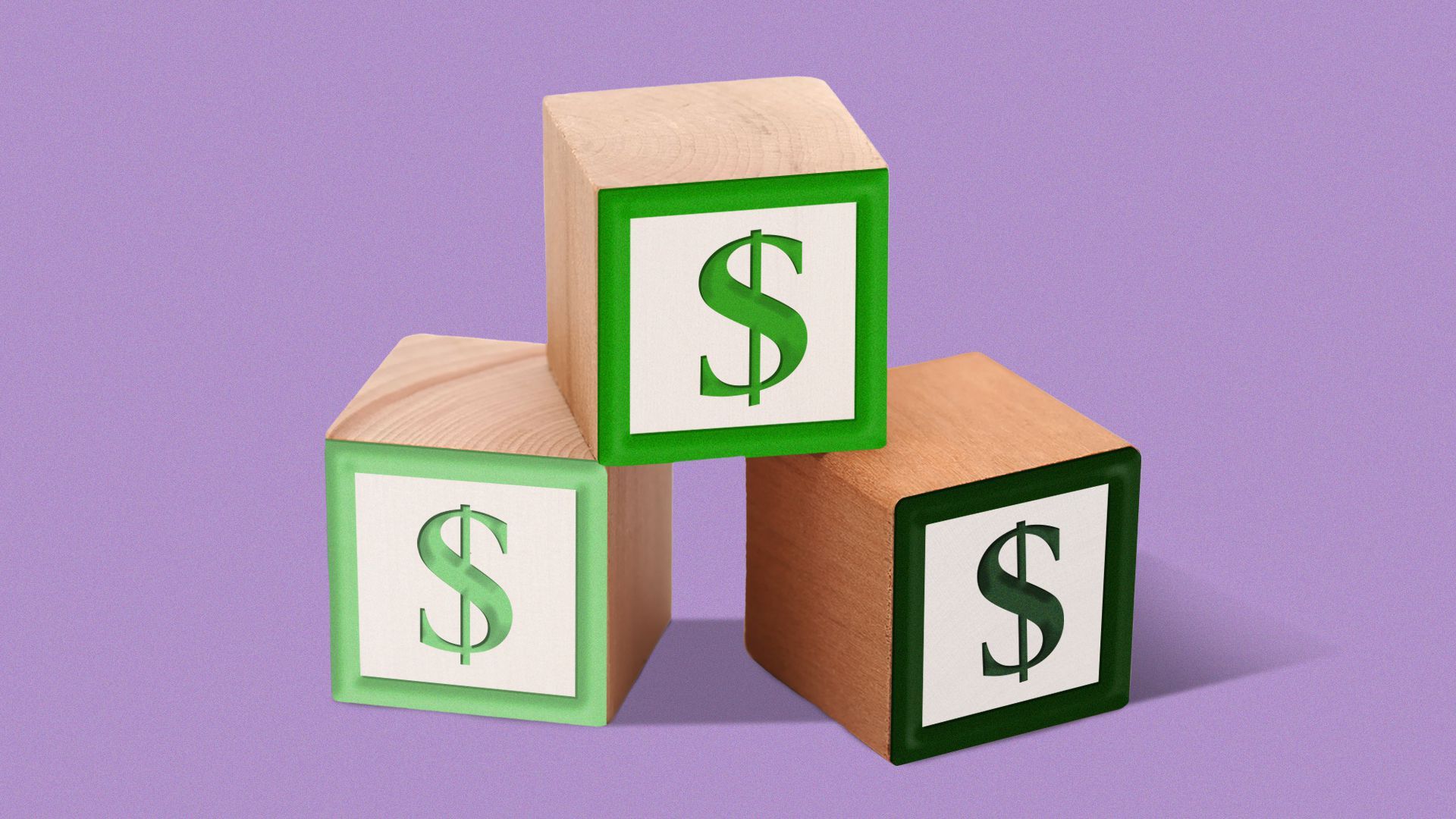| | | | | | | Presented By THE NORTHERN TRUST INSTITUTE | | | | Axios Markets | | By Emily Peck and Matt Phillips · Jun 17, 2022 | | 😅 Friday! We've got a balanced portfolio for y'all this morning — stocks, bonds, and some news about performance reviews. It's that time of the year, you know. Tomorrow, keep an eye out for Felix's inaugural edition of Markets Weekend ... then, we'll all be taking Monday off in observance of the Juneteenth holiday. See you back here on Tuesday morning. Today's newsletter, edited by Kate Marino, is 1,221 words, 4½ minutes. | | | | | | 1 big thing: High (yield) anxiety |  | | | Illustration: Aïda Amer/Axios | | | | Surging borrowing costs are making it tougher for struggling companies to raise new capital — a big shift from the last few years of unusually easy access to markets, Axios' Kate Marino writes. - It's also changing the deal calculus for private equity funds that buy companies using as much borrowed money as they can.
Why it matters: These are examples of how rising rates ripple out into the markets and the lending ecosystem. And when the credit spigot slows, the riskiest borrowers are the first to get choked off. Driving the news: Revlon filed for bankruptcy this week, finally capitulating after staving it off for years with a string of debt-extension deals. - Revlon has long been a "zombie"-type company, able to operate but not pay off debts or invest in growth. The end of the easy money era may be the catalyst that drives more zombies into bankruptcy court.
State of play: Last Friday's inflation report kicked off a re-pricing throughout the credit world, as the benchmark Treasury note hit an 11-year high — and everything else followed suit. - The average yield on high yield (aka non-investment grade) bonds has surged by more than three-quarters of a percentage point since then, to 8.25%. With the exception of a brief window at the beginning of the pandemic, that's the highest it's been since 2016.
- The riskiest subset of high-yield bonds — those with the lowest "CCC" ratings — shot up by a full percentage point, to 14%.
The impact of this volatility splinters out in a few different ways. For one, it inhibits virtually any company with rock-bottom "CCC" ratings that needs to raise money. - Yes, but: The good news is that thanks to the flow of cheap money throughout 2021, few high-yield companies face a make-or-break need to raise cash in the next year or two.
In the private equity world, leveraged buyouts are often backed by high-yield bonds — but some buyouts won't be sound if a chunk of their capital costs 14%. - More equity, less debt, is the theme of the moment.
Where it stands: High-yield placements have slowed to a trickle, with the window opening for brief bursts like the first week of June — before that grim CPI report. What to watch: There may be brief periods where the window is open for lower-rated deals — but until inflation breaks and the Fed can ease back on its tightening campaign, that window will be closed far more often than it's open, says Bill Zox, high-yield portfolio manager at Brandywine Global. Go deeper. |     | | | | | | Bonus chart: It's expensive out there |  Data: ICE BofA CCC & Lower U.S. High Yield Index via FRED; Chart: Axios Visuals |     | | | | | | 2. Catch up quick | | 🇯🇵 Yen hits fresh 20-year low as BOJ sticks with money printing. (Reuters) 📉 World stocks headed for worst week since the 2020 pandemic. (Reuters) 🏭 Metal prices poised for weekly loss, amid worries about growth. (Reuters) |     | | | | | | A message from THE NORTHERN TRUST INSTITUTE | | Create value from values | | |  | | | | Do ESG investments deliver on their promise? Investors worry about sacrificing returns or whether their investments will make a difference. Okay, but: Northern Trust can build a plan that reflects your values and achieves what's most important to you. Learn how. | | | | | | 3. More than a million moms |  | | | Illustration: Shoshana Gordon/Axios | | | | If child care subsidies like those proposed by the Biden administration were enacted — not the likeliest of scenarios at this point — a significant number of women would enter the job market, Emily writes. Why it matters: Despite the policy's slim chances, this is an important paper for the longer term analysis of the issue — likely the first quantitative look at how this type of proposal would affect maternal employment, the cost and quality of child care, and family incomes. - It also suggests a possible solution to the country's stubbornly persistent labor shortage.
Details: The researchers, a team of eight economists who study child care and early education, modeled out the effects of the proposal in Biden's Build Back Better plan — which would cap the amount families spend on child care, for children 5 and under, at no more than 7% of income for those earning up to 250% of median income. - Under the BBB scenario, the share of lower income mothers employed full time would increase by 18 percentage points; while overall there'd be a 10-point increase, amounting to 1.2 million moms.
- Meanwhile, wages for child care work — one of the lowest paying sectors in the U.S. — would increase 19%-29%, depending on the education level of the worker.
Zoom out: The U.S. lags most other high-income countries in terms of maternal employment. - In 2019, the most recent year for which data was available, 68% of mothers with children ages 3–5 were employed in the U.S., ranking the country 32nd on a list of 40.
- The researchers estimate that broad child care support along the lines of the administration's proposal would push the rate up to 78%, putting the U.S. in 9th place.
The bottom line: At the moment, though, with inflation on everyone's mind, this kind of fiscal spending seems far off. Go deeper. |     | | |  | | | | If you like this newsletter, your friends may, too! Refer your friends and get free Axios swag when they sign up. | | | | | | | | 4. 📉 😫 💸 Slump worsens as recession worries grow |  Data: FactSet; Chart: Nicki Camberg/Axios It just seems to be getting worse, Matt writes. Driving the news: The S&P face-planted by another 3.3% on Thursday, pushing the benchmark index's loss for the week to more than 6%. - S&P's 2022 decline is now 23%.
- This puts the index on track for the worst first-half performance since 1962.
What's going on: Energy costs are driving the slump. The price surge is deeply unsettling to the world economy — and Russia just complicated matters further by cutting natural gas flows to Europe. - But it's also what rising energy costs will do to inflation. (Push it up.)
- It's how central banks like the Federal Reserve will react to energy-driven inflation. (Push rates up)
- And most recently, it's what the Fed's reaction to energy-driven inflation will do to economic growth. (Push it down ... potentially way down.)
What happened: Since the most recent inflation report last Friday, so-called "cyclical" stocks — that is, companies whose fortunes are typically most closely aligned to the short-term ups and downs of the economy — have dramatically underperformed the overall market. - That suggests investors are getting increasingly worried that the Fed's effort to curtail surging prices will almost certainly hurt the economy, and the profits of companies — like airlines, energy firms, hotels and banks — which fare better during periods with solid GDP growth.
The intrigue: This is a subtle shift for the markets, which have been selling off all year. - But the first leg of that selloff, analysts say, was driven not so much by worries about the economy, but by a sharp contraction in valuations that was basically a function of higher interest rates.
|     | | | | | | 5. Who are you calling a genius? |  Data: Textio; Chart: Jared Whalen/Axios The tenor of your performance review might depend on your race and gender, Emily writes. - Men tend to get reviews that focus on the substance of their work; while women are 22% more likely to get feedback on their personality, according to a new analysis of performance reviews from 253 companies.
- White and Asian men are far more likely to be described as "brilliant" or "genius" than any other group.
Why it matters: On an individual level, quality feedback about someone's actual work helps them advance in their careers. Bigger picture: the differences in the way people are reviewed reveal biases about gender and race. More details: Women are more likely to be called "overachievers." - Translation: "Brilliant geniuses are expected to perform well; overachievers perform well despite having inherent limitations," Kieran Snyder explains in a column in Fortune. "Some groups are credited with more baseline talent than others."
|     | | | | | | A message from THE NORTHERN TRUST INSTITUTE | | Prices, policy and portfolios — your questions answered | | |  | | | | Protect your portfolio against inflation with answers to common investor questions. The impact: Better understand the impact of inflation and how to fortify your portfolio and wealth plan in the face of uncertainty. Start learning now. | | |  | It's called Smart Brevity®. Over 200 orgs use it — in a tool called Axios HQ — to drive productivity with clearer workplace communications. | | | | | | Axios thanks our partners for supporting our newsletters. If you're interested in advertising, learn more here.
Sponsorship has no influence on editorial content. Axios, 3100 Clarendon Blvd, Arlington VA 22201 | | | You received this email because you signed up for newsletters from Axios.
Change your preferences or unsubscribe here. | | | Was this email forwarded to you?
Sign up now to get Axios in your inbox. | | | | Follow Axios on social media:    | | | | | |













No comments:
Post a Comment